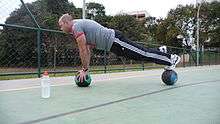Medicine ball
A medicine ball (also known as an exercise ball, a med ball, or a fitness ball) is a weighted ball roughly the diameter of the shoulders (approx. 13.7 inches), often used for rehabilitation and strength training.[1] The medicine ball also serves an important role in the field of sports medicine to improve strength and neuromuscular coordination.[2] It is distinct from the inflated exercise ball, which is larger (up to 36″ diameter).



Medicine balls are usually sold as 2–25 lb (1–11 kg) balls and are used effectively in ballistic training to increase explosive power in athletes in all sports, e.g. throwing the medicine ball or jumping whilst holding it.[3] Some medicine balls are up to 14″ (approx. 36 cm) in diameter and up to 14 lbs weight, or in the form of weighted basketballs.
Hippocrates is said to have stuffed animal skins for patients to toss for "medicinal" purposes.[4] Similar large balls were used in Persia in 1705. The term "medicine ball" dates back to at least 1876, in American Gymnasia and Academic Record, by Robert Jenkins Roberts, Jr. The first known photograph of a medicine ball in the United States was taken in 1866 and shows Harvard athletic instructor Aaron Molyneaux Hewlett surrounded by his equipment.[5]
See also
- Dumbbell
- Exercise ball
- Hooverball
- Kettlebell
- Medicine ball cabinet
References
- "Medicine ball". Merriam-Webster Dictionary. Retrieved 20 February 2014.
- Davies, George; Riemann, Bryan L.; Manske, Robert (November 2015). "Current Concepts of Plyometric Exercise". International Journal of Sports Physical Therapy. 10 (6): 760–786. ISSN 2159-2896. PMC 4637913. PMID 26618058.
- Hartmann, Hagen; Wirth, Klaus; Keiner, Michael; Mickel, Christoph; Sander, Andre; Szilvas, Elena (October 2015). "Short-term Periodization Models: Effects on Strength and Speed-strength Performance". Sports Medicine. Auckland, N.Z. 45 (10): 1373–1386. doi:10.1007/s40279-015-0355-2. ISSN 1179-2035. PMID 26133514.
- Internicola, Dorene (6 October 2014). "Medicine balls are ancient fitness tools that keep bouncing back". Reuters. Retrieved 21 April 2015.
- Fleming, David; Croner, Ken (2012-07-10). "The Ball That Just Won't Die". ESPN.com. Retrieved 2019-02-23.
External links
